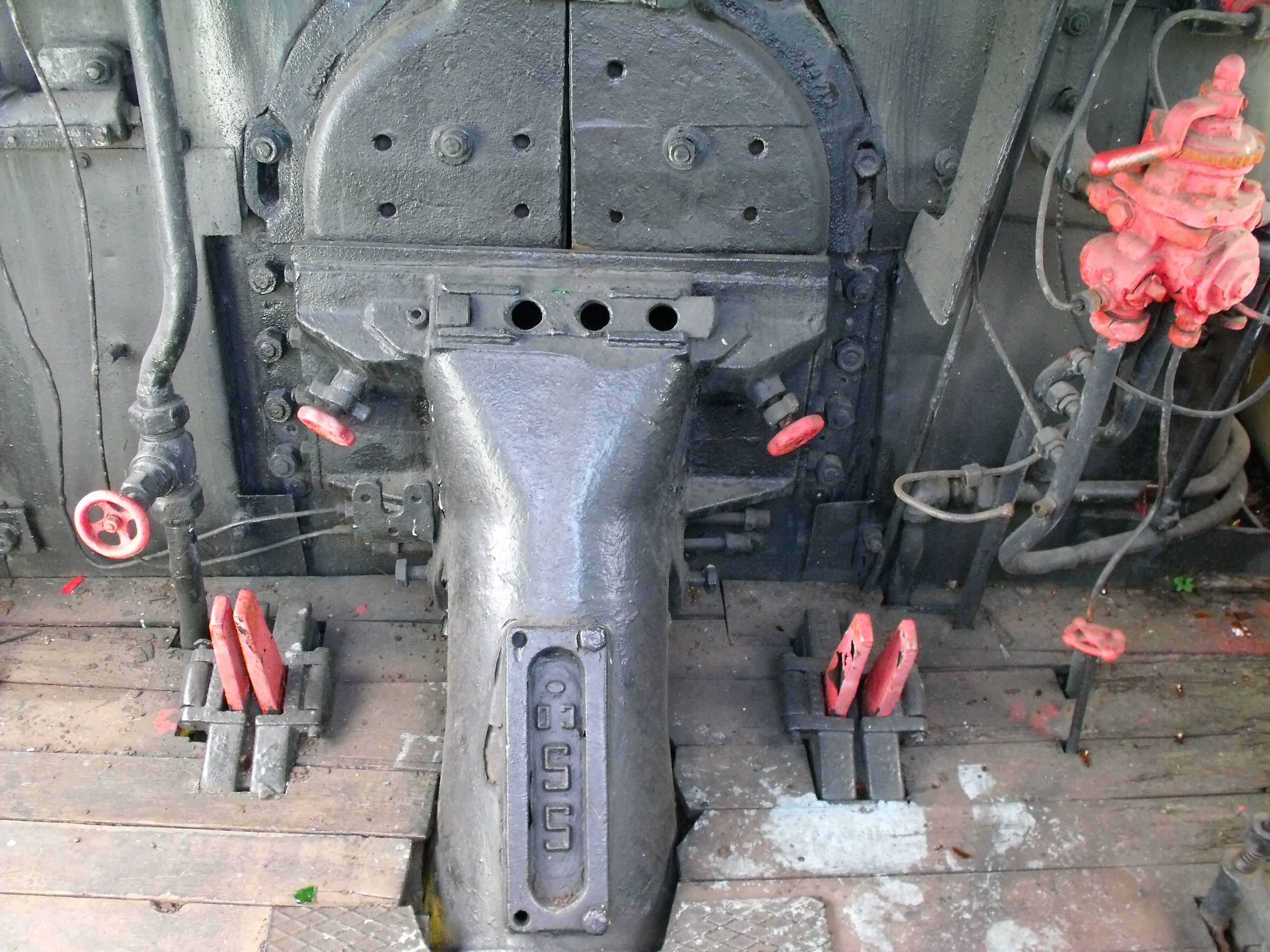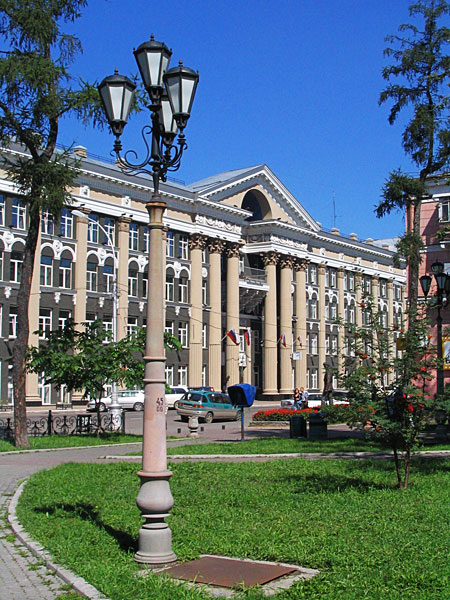|
Russian Locomotive Class P36
The Soviet locomotive class P36 (russian: П36) was a Soviet mainline passenger steam locomotive type. Between 1950 and 1956, 251 locomotives were built. The locomotives were nicknamed "Generals" because of the red stripe down the side. The P36 had the same power as a class IS locomotive but the axle loading of 18 tons allowed its use on the vast majority of Russian railway lines, replacing class Su 2-6-2s and significantly increasing the weight of passenger trains. The P36 was the last type of mainline steam locomotive built in the Russian SFSR and the last one built, P36-0251, was the last steam locomotive produced by Kolomna Works, Russian SFSR.VA Rakov Passenger locomotives series P36 / / Locomotives domestic railways 1845–1955. - 1995. - p320-322. Though sometimes described as the "Victory" type locomotive, that nick-name actually belongs to the class L 2-10-0 built between 1945 and 1947. Development history Background By the early 1940s, the backbone of the Sov ... [...More Info...] [...Related Items...] OR: [Wikipedia] [Google] [Baidu] |
Kolomna Locomotive Works
The Kolomna Locomotive Works (Kolomensky Zavod) is a major producer of railroad locomotives as well as locomotive and marine diesel engines in Russia. The plant started production in 1869 with a freight steam locomotive, one of the first in Russia. In the Czarist period before the Russian Revolution, Kolomna was one of a very few producers in Russia. During this period 139 types of steam locomotives were designed. The company is now (2015) a part of Transmashholding. Overview The main activities of the company are: design, manufacturing and service of diesel engines (medium-speed diesel engines and diesel generators for diesel locomotives, power plants, heavy trucks, ships), mainline locomotives (passenger and freight), DC passenger electric locomotives. The Kolomna plant is the only Russian producer of passenger locomotives, the creator of the first domestic examples of the main high-speed passenger EP200 AC locomotives, passenger DC electric EP2K, freight locomotives 2TE7 ... [...More Info...] [...Related Items...] OR: [Wikipedia] [Google] [Baidu] |
Mechanical Stoker
A mechanical stoker is a mechanical system that feeds solid fuel like coal, coke or anthracite into the furnace of a steam boiler. They are common on steam locomotives after 1900 and are also used on ships and power stations. Known now as a spreader stoker they remain in use today especially in furnaces fueled by wood pellets or refuse. There are three types: the over feed, the under feed and the cross feed. The over feed delivers coal on to the top of the coals already in the furnace in the manner of a human working a shovel. The under feeder pushes fresh coal into the bottom of the furnace and then advances it upwards so that it mixes with the burning coal above. The mechanical means used are, depending on design, combinations of the screw feed, the conveyor belt, the bucket chain, the paddle and the ram. Steam jets from the boiler or a mechanical catapult may also be used to throw coal into the far reaches of the furnace. Use in steam locomotives The confined working c ... [...More Info...] [...Related Items...] OR: [Wikipedia] [Google] [Baidu] |
Passenger Steam Locomotive P36-001 (01)
A passenger (also abbreviated as pax) is a person who travels in a vehicle, but does not bear any responsibility for the tasks required for that vehicle to arrive at its destination or otherwise operate the vehicle, and is not a steward. The vehicles may be bicycles, buses, passenger trains, airliners, ships, ferryboats, and other methods of transportation. Crew members (if any), as well as the driver or pilot of the vehicle, are usually not considered to be passengers. For example, a flight attendant on an airline would not be considered a passenger while on duty and the same with those working in the kitchen or restaurant on board a ship as well as cleaning staff, but an employee riding in a company car being driven by another person would be considered a passenger, even if the car was being driven on company business. Railways In railway parlance, passenger, as well as being the end user of a service, is also a categorisation of the type of rolling stock used.Sim ... [...More Info...] [...Related Items...] OR: [Wikipedia] [Google] [Baidu] |
Far-East Railway
Far Eastern Railway (russian: Дальневосточная железная дорога) is a railway in Russia that crosses Primorsky Krai, Khabarovsk Krai, Amur Oblast, Jewish Autonomous Oblast, and Yakutia. Information The railway administration is located in Khabarovsk. The Far Eastern Railway borders with the Transbaikal Railway at Arkhara Station and Baikal Amur Mainline at Izvestkovaya and Komsomolsk-on-Amur Stations. There are 365 railway stations along the Far Eastern Railway and two border crossings: Grodekovo (Russo-Chinese border) and Khasan (a border between Russia and North Korea). The Railway consists of four divisions: the Khabarovsk Railway Division, Vladivostok Railway Division, Komsomolskoye Railway Division, and Tynda Railway Division. The biggest points of cargo departure and arrival are Khabarovsk-2, Izvestkovaya, Birobidzhan, Volochayevka-2, Komsomolsk-on-Amur, Sovetskaya Gavan, Sibirtsevo, Ussuriysk, Baranovsky, Uglovaya, Vladivostok, ... [...More Info...] [...Related Items...] OR: [Wikipedia] [Google] [Baidu] |
East Siberian Railway
The East Siberian Railway () is a railway in Russia (a branch of the Russian Railways and a part of the Trans-Siberian Railway), which runs across Irkutsk Oblast, Chita Oblast, Buryatia, and Yakutia. The railway administration is located in Irkutsk. The East Siberian Railway borders with the Krasnoyarsk Railway (railway station of Yurty), Trans-Baikal Railway (railway station of Petrovsky Zavod), and Baikal Amur Mainline (railway station of Lena-Vostochnaya). To the south, the East Siberian Railway runs close to the Russo-Mongolian border (railway station of Naushki). As of 2008, the total working length of the East Siberian Railway was ; number of employees – 46,233 (61,418 in 2005); net weight hauled – 76 million tonnes (75.934 million in 2005); long-distance passenger traffic – 3.6 million people (4.838 million in 2005); suburban traffic – 29 million people (26.225 million in 2005). Annual cargo turnover is 278 million tonnes. The East Siberian Railway consists ... [...More Info...] [...Related Items...] OR: [Wikipedia] [Google] [Baidu] |
Northern Railway (Russia)
The Severnaya Railway (Северная железная дорога; "Northern Railway") is a railway network linking Moscow with Arkhangelsk on the coast of the Arctic Ocean. It runs through Arkhangelsk, Komi, Vologda, Kostroma, Yaroslavl, Ivanovo, and Vladimir regions of the Russian Federation. Northern Railway counts its age from 15 September 1868 when its first part, Shuya-Ivanovo Railway connecting Ivanovo, Shuya and Novki, was opened. The Yaroslavl Railway, owned by Savva Mamontov, was one of the first railways in Russia. The Alexandrov–Yaroslavl–Vologda line was opened in 1872. There are several monuments to Savva Mamontov along the road. The original Moscow–Yaroslavl Mainline is no longer operated from Yaroslavl; it was transferred to the Moscow Railway in 1959. Yaroslavl-Vologda-Arkhangelsk line In 1894, the construction of the railway connecting Vologda with Arkhangelsk started. The decision was taken to construct the line along the shortest route, wh ... [...More Info...] [...Related Items...] OR: [Wikipedia] [Google] [Baidu] |
Trans-Baikal Railway
The Trans-Baikal Railway (Забайкальская железная дорога) is a subsidiary of the Russian Railways headquartered in Chita and serving Zabaykalsky Krai and Amur Oblast. The mainline was built between 1895 and 1905 as part of the Trans-Siberian Railway. It bordered the Circum-Baikal Railway on the west and the Chinese Eastern Railway on the east. The railway bore the name of Vyacheslav Molotov between 1936 and 1943. The Amur Railway became part of the network in 1959. As of 2009, the railway employs 46 741 people; its route length totals 3336,1 km.http://zabzd.rzd.ru/ See also * Circum-Baikal Railway * Transmongolian Railway , map_name = , map_state = collapsed , embedded = The Trans-Mongolian Railway follows an ancient tea-caravan route from China to Russia and connects Ulan-Ude, on the Trans–Baikal ( Trans–Siberian) railway in Rus ... References External linksTransbaikal Railway. Postcards, 1905-19 ... [...More Info...] [...Related Items...] OR: [Wikipedia] [Google] [Baidu] |
Ilansky (town)
Ilansky (russian: Ила́нский) is a town and the administrative center of Ilansky District of Krasnoyarsk Krai, Russia, located on the Ilanka River east of Krasnoyarsk. Population: History It was founded in 1645 as the village of Ilanskaya (). Town status was granted to it in 1939. Administrative and municipal status Within the framework of administrative divisions, Ilansky serves as the administrative center of Ilansky District.Law #10-4765 As an administrative division, it is, together with the village A village is a clustered human settlement or community, larger than a hamlet but smaller than a town (although the word is often used to describe both hamlets and smaller towns), with a population typically ranging from a few hundred to ... of Algasy, incorporated within Ilansky District as the town of district significance, district town of Ilansky. As a subdivisions of Russia#Municipal divisions, municipal division, the district town of Ilansky is inco ... [...More Info...] [...Related Items...] OR: [Wikipedia] [Google] [Baidu] |
Taishet
Tayshet ( rus, Тайшет, p=tɐjˈʂɛt, lit. ''cold river'' in the Kott language) is a town and the administrative center of Tayshetsky District in Irkutsk Oblast, Russia, located northwest of Irkutsk, the administrative center of the oblast. Population: History It was founded in 1897 as a supply point and station on the Trans-Siberian Railway and was granted town status in 1938. During the 1930s–1950s, Tayshet was the center of administration for gulag labor camps Ozerlag and Angarstroy. Construction of the first section of the Baikal–Amur Mainline started in 1937 and was managed from here. According to some survivor accounts, between Tayshet and Bratsk there is "a dead man under every sleeper." Along with Japanese prisoners from the Kwantung Army, German prisoners of war formed a large proportion of the forced labor contingent, generally under a 25-year sentence, such as Dietrich von Saucken. Surviving German POWs were repatriated in autumn of 1955, after West Germ ... [...More Info...] [...Related Items...] OR: [Wikipedia] [Google] [Baidu] |
20th Congress Of The Communist Party Of The Soviet Union
The 20th Congress of the Communist Party of the Soviet Union was held during the period 14–25 February 1956. It is known especially for First Secretary Nikita Khrushchev's " Secret Speech", which denounced the personality cult and dictatorship of Joseph Stalin. Delegates at this Congress of the Communist Party of the Soviet Union were given no warning of what to expect. Indeed, proceedings were opened by First Secretary Khruschev's call for all to stand in memory of the Communist leaders who had died since the previous Congress, in which he mentioned Stalin in the same breath as Klement Gottwald. Hints of a new direction only came out gradually over the next ten days, which had the effect of leaving those present highly perplexed. The Polish communist leader Bolesław Bierut died in Moscow shortly after attending the 20th Congress. The congress elected the 20th Central Committee. Secret speech On 25 February, the last day of the Congress, it was announced that an uns ... [...More Info...] [...Related Items...] OR: [Wikipedia] [Google] [Baidu] |
Krasnoyarsk
Krasnoyarsk ( ; rus, Красноя́рск, a=Ru-Красноярск2.ogg, p=krəsnɐˈjarsk) (in semantic translation - Red Ravine City) is the largest city and administrative center of Krasnoyarsk Krai, Russia. It is situated along the Yenisey River, and is the second-largest city in Siberia after Novosibirsk, with a population of over 1.1 million. Krasnoyarsk is an important junction of the renowned Trans-Siberian Railway, and is one of the largest producers of aluminium in the country. The city is known for its natural landscape; author Anton Chekhov judged Krasnoyarsk to be the most beautiful city in Siberia. The Stolby Nature Sanctuary is located 10 km south of the city. Krasnoyarsk is a major educational centre in Siberia, and hosts the Siberian Federal University. In 2019, Krasnoyarsk was the host city of the 2019 Winter Universiade, the third hosted in Russia. Geography The total area of the city, including suburbs and the river, is .Poexaly.ru. Krasnoya ... [...More Info...] [...Related Items...] OR: [Wikipedia] [Google] [Baidu] |







